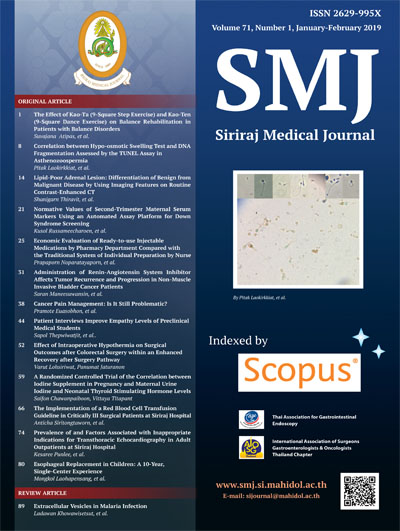Effect of Kao-Ta (9-Square Step Exercise) and Kao-Ten (9-Square Dance Exercise) on Balance Rehabilitation in Patients with Balance Disorders
DOI:
https://doi.org/10.33192/Smj.2019.01Keywords:
Kao-ta; Kao-ten; balance rehabilitation; patients; balance disorders; Thai traditional medicineAbstract
Objective: To study the effect of Kao-ta (9-square step exercise) and Kao-ten (9-square dance exercise) on balance improvement in patients with balance disorders.
Methods: This prospective pilot study in patients with balance disorders was conducted at the outpatient clinic, Department of Otorhinolaryngology, Faculty of Medicine Siriraj Hospital, Mahidol University, Bangkok, Thailand from December 2015 to December 2016. Patients diagnosed by clinical symptoms and at least one abnormal
condition on posturography were taught how to perform Kao-ta and Kao-ten exercise. Participants were provided with the equipment necessary to create a nine square grid at home. They were instructed to perform 3 minutes of Kao-ta followed by 2 minutes of Kao-ten twice per day for at least 45 days in an 8-week period. Posturography and visual analogue scale (VAS) of balance symptom severity were compared between before and after exercise program.
Results: Eleven patients with balance disorders were included. The mean age was 57.2±12.9 years (range: 33-70), and all patients were women. The average composite equilibrium score at baseline was 64.4±8.1. After 8 weeks of Kao-ta and Kao-ten, the average composite equilibrium score increased to 73.8±10.2 (p<0.01). The median (P25, P75) of the abnormal equilibrium score condition decreased from 2 (1, 3) at baseline to 1 (0, 2) after 8 weeks (p=0.016). The median VAS of balance symptom severity decreased from 4 (3, 6) at baseline to 2 (0.2, 5.5) after 8 weeks (p=0.028).
Conclusion: Kao-ta and Kao-ten exercise can improve symptoms in patients with balance disorders after 8 weeks of exercise.
Downloads
Published
How to Cite
Issue
Section
License
Authors who publish with this journal agree to the following conditions:
Copyright Transfer
In submitting a manuscript, the authors acknowledge that the work will become the copyrighted property of Siriraj Medical Journal upon publication.
License
Articles are licensed under a Creative Commons Attribution-NonCommercial-NoDerivatives 4.0 International License (CC BY-NC-ND 4.0). This license allows for the sharing of the work for non-commercial purposes with proper attribution to the authors and the journal. However, it does not permit modifications or the creation of derivative works.
Sharing and Access
Authors are encouraged to share their article on their personal or institutional websites and through other non-commercial platforms. Doing so can increase readership and citations.














